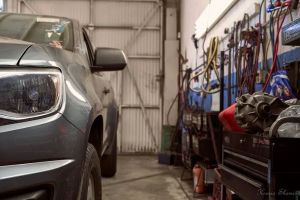How to Diagnose and Solve Car Electrical Problems: A Step-by-Step Guide
Ever found yourself stranded on the side of the road, your car refusing to start or your lights flickering unpredictably? It's a common nightmare that many car owners face, and often, the culprit is an electrical problem. The good news is that diagnosing and solving car electrical issues doesn't always require a professional mechanic—sometimes, all it takes is a little patience and knowledge. In this guide, I’ll walk you through everything you need to know to diagnose and fix car electrical problems on your own.

Craig's Auto Repair
11037 Stranwood Ave, Mission Hills, CA 91345, USA
1. Understand the Basics of Car Electrical Systems
Before diving into troubleshooting, it’s essential to understand how your car’s electrical system works. At its core, the electrical system powers various components like the battery, alternator, fuses, lights, and even the ignition system. The electrical system is crucial for everything from starting the engine to running the car's entertainment and navigation systems.
There are a few key components in your car's electrical system:
- Battery: Stores electrical energy to power your car when the engine isn’t running.
- Alternator: Keeps the battery charged while the engine is running.
- Fuses: Protect the electrical circuits by preventing overloads.
- Wires and connectors: Carry electrical power to different parts of your vehicle.
2. Diagnosing Common Electrical Issues
Now that you have a basic understanding of your car's electrical system, let’s walk through the most common electrical issues and how to diagnose them.
1. Battery Problems
The first place to check when your car won’t start is the battery. A dead or dying battery is the most common culprit. To check the health of your battery:
- Inspect the battery terminals for any corrosion or loose connections.
- Use a multimeter to measure the battery voltage. A fully charged battery should read around 12.6 volts.
- If the voltage is lower than 12 volts, it’s likely that the battery is drained or faulty and needs to be replaced.
If you find corrosion, cleaning the battery terminals with a mixture of baking soda and water may help. A quick jump-start from another vehicle can also temporarily resolve a dead battery, but replacing it should be your next step if it continues to fail.
2. Alternator Issues
If your car’s electrical system seems fine when the engine is off but begins to fail when the engine is running, the alternator could be the problem. A faulty alternator can’t charge the battery properly, leaving you with no power.
To test the alternator:
- Start the car and check the voltage at the battery. It should be between 13.8 and 14.4 volts.
- If the voltage is too low, your alternator is likely failing and needs to be replaced.
3. Blown Fuses
Fuses are designed to protect your car’s electrical circuits from short circuits or overloads. If you notice that certain features (like your headlights or radio) aren’t working, it could be because a fuse has blown. Fortunately, this is an easy fix!
To check your fuses:
- Locate your car's fuse box. It's usually under the dashboard or in the engine bay.
- Look for any fuses that appear burnt or broken.
- If you find a blown fuse, replace it with one of the same amperage rating.
3. Common Electrical Problems and Their Solutions
1. Flickering Lights
Flickering headlights or interior lights are typically caused by a weak battery, poor alternator performance, or bad connections. If the alternator isn’t working correctly, it can’t keep the battery charged, which may cause electrical components to behave erratically.
To fix flickering lights:
- First, check the battery voltage and clean the terminals if necessary.
- Next, check the alternator’s performance. If it’s faulty, replacing it should solve the issue.
- Also, inspect the wiring and connectors for signs of damage or corrosion.
2. Car Won’t Start
If your car won’t start and you’ve ruled out a dead battery, it could be due to a faulty starter, ignition switch, or a loose connection. Diagnosing this issue requires checking each component.
Start by checking the ignition switch and starter motor. If they’re functioning correctly, inspect the wiring for any loose connections or fraying.
3. Electrical Overload
If you’ve recently added aftermarket electrical devices like a new stereo system or LED lights, an electrical overload may be the issue. This happens when the car’s electrical system is overloaded, usually because the alternator can’t keep up with the extra demand.
To solve this problem, you may need to upgrade the alternator or remove some of the additional devices. Always ensure that the electrical system in your car is equipped to handle extra loads.
4. When to Call a Professional
While many electrical issues can be diagnosed and solved at home, there are times when it’s best to call a professional mechanic. If you’ve checked the battery, alternator, fuses, and wiring but are still experiencing electrical issues, it’s time to seek professional help. Additionally, if you’re not comfortable working with electrical components, it’s safer to leave it to the experts.
If you ever find yourself in a situation where your car breaks down due to an electrical issue, you can find reliable towing services through Rescue & Towing to get your vehicle safely to a shop for repair.




























